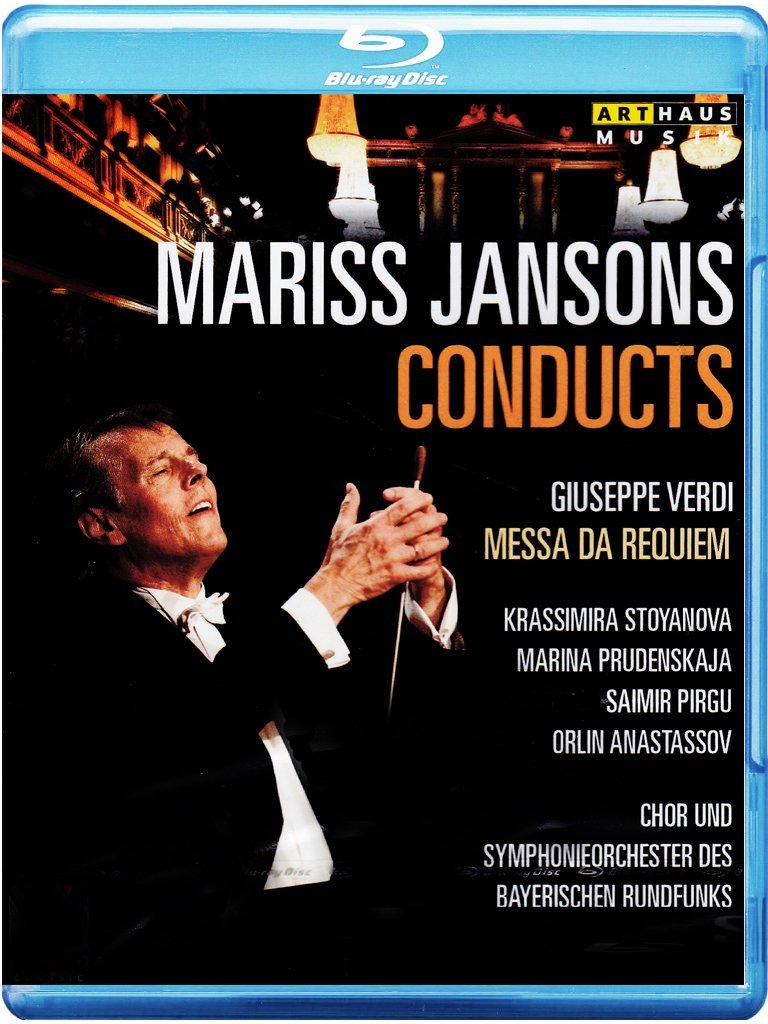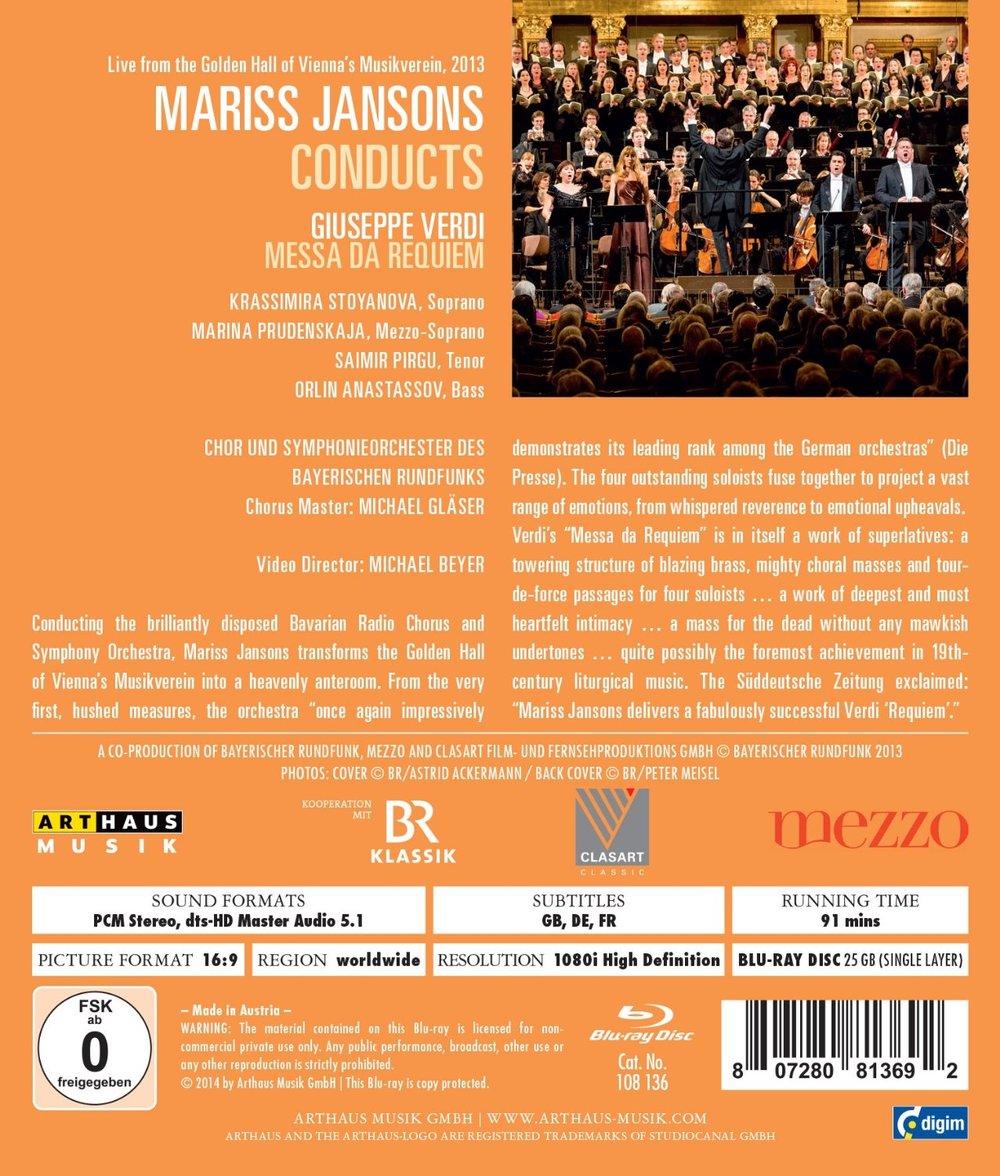

Verdi Messa da Requiem. Recorded 2013 at the Golden Hall of Vienna’s Musikverein. Mariss Jansons conducts the Bavarian Symphony Orchestra and the Bavarian Radio Chorus (Chorus Master Michael Gläzer). Soloists are Krassimira Stoyanova (soprano), Marina Prudenskaja (mezzo-soprano), Saimir Pirgu (tenor), and Orlin Anastassov (bass). Directed for TV by Michael Beyer. Sung in Latin. Released 2014, disc has 5.1 dts-HD Master Audio sound. Grade: B+
This review was contributed by Wonk Bryan Balmer. Thank you Bryan!
Mariss Jansons:
Krassimira Stoyanova left and Marina Prudenskaja on the right:
Saimir Pirgu left and Orlin Anastassov right:
This Verdi Messa da Requiem was a Gramophone "Editor's Choice" selection for the month of January 2015. Mike Ashman at page 75 praises Jansons' "operatic" approach to the work showing "a good sense of theatre." He also praised the video in its DVD version stating, "It's atmospherically filmed without encompassing an architectural tour of the venue and points intelligently to vocal and instrumental leads." H'm, this would prepare me to find a pretty grim case of DVDitis in the Blu-ray; instead, this disc turned out to be a pleasant surprise! A gripping and dramatic performance was matched by thoughtful and careful filming by director Michael Beyer.
For more on the dread disease "DVDitis" see our special article on how to make a decent video of a large orchestra for viewing on HD TV. Briefly, DVDitis is a malady that afflicts Blu-ray videos with content that is only appropriate for a DVD. We use a Wonk Worksheet to accurately diagnose DVDitis in a Blu-ray recording. For more information about all this and the abbreviations used below, refer to our Wonk Worksheet form and Wonk Worksheet Instructions):
Following are statistics, obtained using a Wonk Worksheet, on the various types of video clips found in subject Verdi Messa da Requiem video:
Conductor = 87
C/B = 26 (conductor over the backs of musicians)
Soloist(s) not realistic = 101 (the soloists here are the 4 star singers)
*Soloist(s) realistic = 105
Solos, S§, SG, & misc. small-scale = 188 (small-scale shots that are needed for DVDs)
*L§, LG, & misc. large-scale = 34 (large-scale shots tend to look good only in HDVDs)
*PO = 23 (part-orchestra)
*WO = 7 (whole-orchestra)
IO = 22 (instrument only)
*Other high value = 4 (here “architectural” shots)
There's a total of 597 clips over 87 minutes of music in this video, which yields a pace of 8.7 seconds per clip. Supershots (marked above with an *) amount to 29% of the total clips, while conductor shots come in at 19%. 51% of soloist shots are realistic.
We have established the following rules-of-thumb to determine when a Blu-ray with star soloists is afflicted by DVDitis:
“A good symphony HDVD with star soloists should have a slow pace with more than 10 seconds per video clip on average. 20 to 40% of the clips should be large-scale "supershots." TatL conductor shots should be less than 20% of the clips in the video. Over 50% of soloist shots should be realistic.”
This video passes 3 of the 4 tests. The only test it flunks is the pace test. But the pace of 8.7 seconds per clip is closer to the pace of a good HDVD (10 seconds per clip and longer) than to the 5 seconds per clip often encountered in DVDs.
Sound quality is good. There is excellent presence to the bass drum during hair-raising moments such as opening of the Dies Irae! As you can see from all our screenshots, Beyer's picture quality is gorgeous with state-of-the-art video resolution and natural color saturation. Further Beyer has mastered the art of achieving close-to-perfect focus throughout the entire relevant depth-of-field-of-focus.
If you are comparing this review to the Blu-ray dics released by Decca of Barenboim performing Messa da Requiem with the Teatro alla Scala, I will offer the following comments:
Similar to Barenboim, there are no Latin subtitles included in this Blu-ray. Subtitles in English, German, French and Korean appear to be adequate. (Personally, I am not in the habit of watching subtitles in concert works because to me they distract from the music.)
The Barenboim performance, directed by Andy Sommer, contains 52 cuts in the 2:28 duration of the opening of the Dies Irae. This present Beyer production contains 26 cuts in the same section (over a duration of 2:25 due to an ever so slightly quicker tempo). This illustrates why the pace in subject title is so much slower and better than in the Barenboim recording. Well, 26 cuts in the Dies Irae is still too many, but it's a step in the right direction!
The Golden Hall of Vienna’s Musikverein is relatively small. The big orchestra with chorus is cramped, and this results in cluttered views of musicians and choristers. I did not see many video errors. However, both the large-scale and small-scale shots in this title are perhaps more utilitarian and “not as pretty” as the pictures you would get in in larger concert halls. (See also another Barenboim title I recently reviewed, Bruckner Symphony No. 8, shot by Andreas Morell at the Berlin Philharmonie with its large stage. Morell captures many images showing the exquisite symmetry of motion that exits in a symphony orchestra performance. This would be too much to hope for at the Golden Hall.)
Now lets turn to screen shots to illustrate the dry text that one contends with in our symphony reviews. We start with 2 architectural shots of the beautiful Golden Hall:
And next (extraordinary tricky and successful) shot below is a combo of an architectural view and trumpets playing off stage during the Dies Irae:
One of the hallmarks of a good HDVD is lots of whole-orchestra and other large-scale clips. Next below is an example of a WO shot (well over 90% of all the players). This is a beautiful image, but it also shows how cramped the stage at the Golden Hall gets with a big orchestra:
This video only has 7 WO clips, but there are also 23 nice part-orchestra (PO) angles including the next shot below, slightly zoomed in to align more closely to the width of the choir:
There were also cameras that provided PO (and other) views from the other side of the hall:
The next few clips provide illustration as to why “Soloist(s) realistic” clips count as “supershots.” As seen below, the only difference between these and WO/PO/Large shots is that the soloists are performing:
As mentioned previously, the small hall contributes to the cramped and crowded feel of many of the large-scale clips:
The singing sardines:
Did management mount airline seats on the stage for the brass row?
The double-basses have a little more breathing room in the upper corner of the stage:
The two views below could be called "unrealistic soloist" clips (at least one soloist is singing in each). But I classified both as “C/B” (conductor-over-backs) shots as I felt that was the director’s intention:
Time for a grade. We start with an A+. I deduct one full grade for flunking the pace test and arrive at a B+. The marginal passing grades for several of the other video content tests are balanced by the very strong performance of this complex work and the beautiful PQ. We have given Michael Beyer many bad grades for his symphony videos due to severe DVDitis. But when a symphony work has soloists (singers or instrumentalists) and/or a chorus, the problem of DVDitis is usually reduced. The soloists give the video director something better to focus on than the conductor, and this helps the title to pass the conductor test. Once a soloist starts to perform, the videographer is reluctant to interrupt that performance with numerous video cuts. This helps to slow down the pace. We also deem realistic shots of soloists and the chorus to be supershots, so this help the disc to pass the supershot test. The result is a pleasing recording (that could have been better). I feel sorry for Mike Ashman (the Gramophone reviewer) if he didn't get the see this in Blu-ray.
OR




















